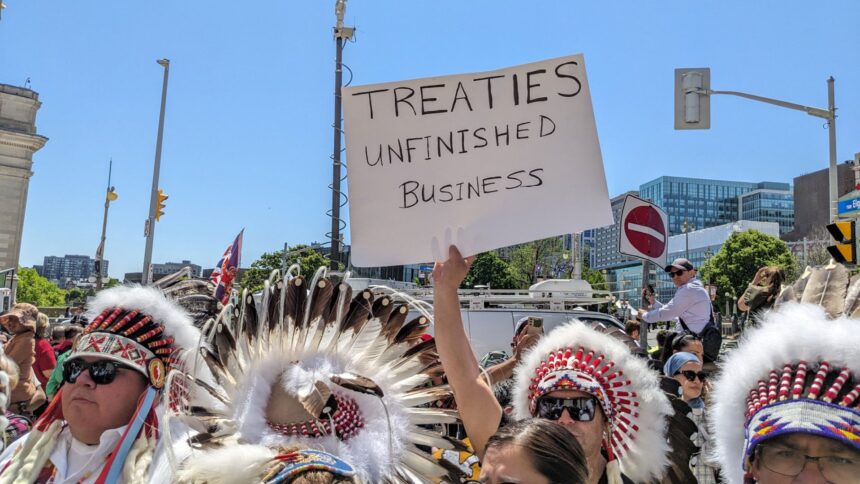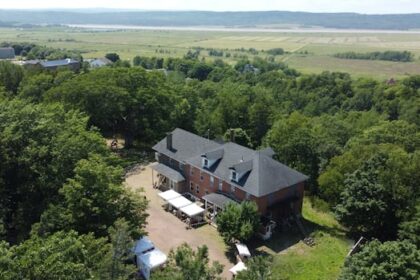In 2025, the Crown remains no stranger to its old playbook by using legislation to simultaneously exclude Indigenous people while pretending to include us. Across Turtle Island—from Queen’s Park to Parliament Hill—new bills are being passed that protect profits, not people. Federal Bill C-5 and Ontario’s Protect Ontario by Unleashing our Economy Act (Bill 5) may seem focused on different sectors—energy versus development—but they are woven from the same colonial fabric. And now, First Nations leaders are warning of civil unrest if governments ignore Indigenous demands for real participation. Let’s begin with the federal Bill C-5. Purportedly designed to streamline approvals for national energy infrastructure, it’s being denounced by Indigenous leadership not because they want a veto, but because they want to be properly consulted. The Assembly of First Nations (AFN) made it plain. First Nations don’t seek a veto, but they demand meaningful consultation—a right recognized under Section 35 of the Constitution. “You want to have this big national discussion. You don’t want to end up back in court. You don’t want to have civil unrest. Why not just invite us to the table, then? Let’s talk,” Assembly of First Nations National Chief Cindy Woodhouse Nepinak told a Senate committee. Yet Bill C-5 allows decisions to move forward without that invitation. It is a template for bypassing Indigenous nations, favoring state-defined “progress” over Indigenous sovereignty. Tensions could escalate. Some Indigenous leaders are warning of potential civil unrest if governments move ahead on Bill C-5—or related infrastructure projects—without addressing these consultation failures. This is not posturing. It is a threat born from centuries of broken promises. When rights are ignored, people may feel compelled to act—and loudly. Indigenous nations have reached a critical point Over at Queen’s Park, Ontario’s Bill 5—the “Protect Ontario by Unleashing our Economy Act”—mirrors the federal playbook on land, environment, and local planning. Premier Doug Ford’s government legislation has centralized decision-making power, weakened environmental assessments, and fast-tracked projects that cut through First Nations territories—without free, prior, and informed consent. Ford’s government says this is about protecting Ontario. But in reality, it protects land speculators, developers, and a narrow economic orthodoxy. What’s sacrificed? Watersheds, sacred lands, and Indigenous authority. Fewer checks, less oversight, more bulldozers—a story all too familiar. When two sets of colonizing laws—from federal and provincial governments—move in tandem, Indigenous peoples don’t just raise concerns. They mobilize. When the federal Bill C-5 threatens forthcoming unrest, it’s a signal. This isn’t theoretical. Indigenous nations have reached a critical turning point. These bills signal a broader truth: the Crown, cloaked in reconciliation talk, remains fundamentally colonial. Whether it’s about energy or economy, the message is the same—Indigenous voices can speak, but only if they don’t stand in the way of government-defined “progress.” Let’s be clear, symbolic gestures—like orange shirt campaigns or commemorative statutes—are not enough. Reconciliation must be about altering power structures, not just staging optics. It must include shared decision-making, land back, and recognition of Indigenous legal systems—not superficially consulted legislation. Treaties are not relics—they are binding, living agreements. But through both Bill C-5 and Ontario’s Bill 5, the Crown is sending a message: treaties can be overridden by technocratic ease and economic ambition. And in response? Indigenous nations are preparing, and unrest may no longer be rhetoric—it may be imminent. When Indigenous leaders warn that civil unrest is possible, they are not escalating tensions. They are revealing a broken relationship—a relationship built on one-sided power. And that power is being wielded through new laws in 2025. At the same time, the Crown is scapegoating Indigenous folks as barriers to the Crown’s vision of an economic utopia of riches and untold wealth. Recent remarks by Premier Ford —described as “deeply offensive and racist” by Oji-Cree MPP Sol Mamakwa—on the relationship with Ontario’s First Nations raised the temperature. Coming on the eve of a meeting with the Chiefs of Ontario, Ford vilified First Nations in the province as beggars, always “coming hat in hand all the time to the government” and seeking handouts while rejecting development in their territories. But First Nations are not necessarily opposed to development. Indigenous nations have long advocated for partnership and cooperation with the Crown. Earlier this year, Canada and 15 First Nations in the area of the Ring of Fire announced such a cooperative agreement. In January, these First Nations and the Impact Assessment Agency of Canada released their joint Terms of Reference to co-lead a regional assessment of future impacts of developments, such as mining, in their traditional treaty lands. Reconciliation will not arise from Ottawa or Queen’s Park. It will only come when Indigenous nations sit as equal partners in lawmaking—not after the fact, not via notification, and not in narrow legislative silos. If the Crown refuses to include us fully, respectfully, and lawfully, then unrest isn’t a risk—it is a response. And perhaps, after some inaction in recent times, we may once again be idle no more. Continue Reading
Idle but always watching: The Crowns nation-building agenda and the potential of Indigenous uprising

Leave a Comment









